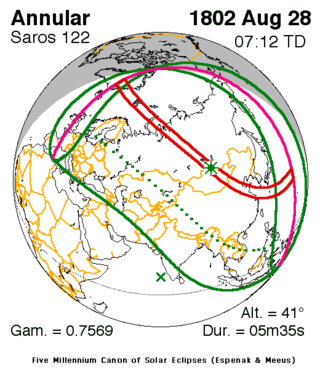Solar eclipse of August 28, 1802
| Solar eclipse of August 28, 1802 | |
|---|---|
| Type of eclipse | |
| Nature | Annular |
| Gamma | 0.7569 |
| Magnitude | 0.9367 |
| Maximum eclipse | |
| Duration | 335 s (5 min 35 s) |
| Coordinates | 51°18′N 105°42′E / 51.3°N 105.7°E |
| Max. width of band | 354 km (220 mi) |
| Times (UTC) | |
| Greatest eclipse | 7:12:00 |
| References | |
| Saros | 122 (46 of 70) |
| Catalog # (SE5000) | 9046 |
An annular solar eclipse occurred on August 28, 1802. A solar eclipse occurs when the Moon passes between Earth and the Sun, thereby totally or partly obscuring the image of the Sun for a viewer on Earth. An annular solar eclipse occurs when the Moon's apparent diameter is smaller than the Sun's, blocking most of the Sun's light and causing the Sun to look like an annulus (ring). An annular eclipse appears as a partial eclipse over a region of the Earth thousands of kilometres wide. The eclipse was visible in Asia and Europe, while the annularity was seen in Russia, Mongolia, and China.[1]
See also[edit]
References[edit]
- ^ "Solar eclipse of August 28, 1802". NASA. Retrieved June 15, 2012.
External links[edit]




